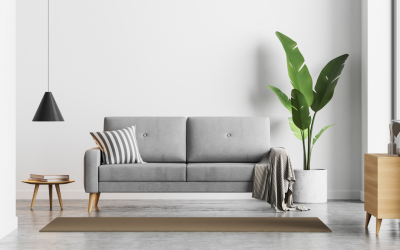Lifestyle changes, adapting to illness or mobility issues, or simply the natural ageing process means that we sometimes have to re-assess the way we live and adapt our homes accordingly. We all want to make sure we’re as comfortable and relaxed as possible in our own environment and there are many ways in which our homes can be redesigned to fit our changing lifestyle, whether you’ve just moved to a new house, or want to stay put in your current abode.
Elements of design are important, as is committing to using up and coming technologies, but these shouldn’t be needlessly complicated or cause undue stress. With the right ideas, planning and guidance from professionals and experts, even the smallest alterations can make you feel more confident and relaxed about your surroundings.
Here we’ll take a look at major rooms in the house and see what design features and changes can be made as we examine tips to make your home more accessible.
1. Bedroom
One of the simplest ways to make a bedroom much more comfortable is to look at choosing a bed that fits your needs.
It could be a simple change such as buying a firmer mattress, looking at investing in memory foam if you suffer from joint or mobility problems, or even buying a brand-new bed. Adjustable beds are a real boon to many who find themselves bedroom bound for a greater part of the day as they can be adapted to suit your needs at different times. For instance, they can always be adjusted to make it comfortable to sit up and read or watch TV with the simple press of a button.
2. Wardrobe and closet space
Think about how you currently gain access to your clothes. Some people find the installation of adaptations such as closet bars can make it easier to select what to wear, especially if you’re wheelchair bound. Look into the possibility of automatic closet bars too, as they will ‘bring’ your clothing to a seated level, for even easier access.
Inside a wardrobe, using wire drawers, or ones that are made from strong, clear plastic can be used so that it is easy to see what is kept in there and also easy to access.
3. Bathroom
Taking time out to bathe and shower is an experience that most of us find relaxing, bt once mobility issues occur, it can seem like a difficult and sometimes traumatic experience.
There are obvious considerations when re-adapting your bathroom, such as looking at the size and shape of your bath, shower and sink, as well as thinking about specially adapted taps and flushes.
The major consideration when adapting a bathroom is to make it as comfortable and user-friendly as possible so that independent toileting and bathing can be carried out, without causing additional stress.
Here are some suggestions for adapting a bathroom:
Bathroom doors may need to be altered, or widened, especially if wheelchair access is needed.
Think about selecting a walk-in bath, or shower. These usually have additional features such as a door, grab bars and a comfortable seat, which give the user simple access and a real sense of independence. An added bonus is that they’re also relatively easy to clean and maintain.
Balance or grab bars can be fitted to walls relatively inexpensively, they can aid mobility in a bathroom.
Think about adjusting a toilet, it might just be the seat height that needs to be altered or sourcing a specially adapted seat for different needs.
If you have cabinets around your bathroom sink, they can be removed to allow for wheelchair access. In an around the sink, taps can easily be replaced with single push or lever controls.
4. Kitchen
Many people see the kitchen as the hub of the home, the place where everyone gathers together to talk, eat and socialize, especially if the space itself is open plan.
If you’re currently living in a home which isn’t open plan and your space will allow for this, it might be worth thinking about turning your living space and kitchen into one, large, open space which will give easy access if your mobility is limited or if you’re in a wheelchair.
Kitchen workstations can be planned and adapted with low counters and/or knee spaces that will accommodate a wheelchair, especially under sinks and some brands of stove top.
As with your bathroom, it might be worth thinking about replacing taps with single lever/push controls to give easier access.
One other consideration is your kitchen flooring. Some people with mobility issues, or certain other health conditions find that the kitchen can sometimes become too hot and humid to cope with. Installing tile, or porcelain tiled floors will help keep it cooler and fresher.
Other adaptations like installing air conditioning, or fans throughout can also help keep temperatures down and the air moving.
5. Living room
Our living rooms are where we go to relax and unwind or sit comfortably to talk to family and friends.
One of the simplest adaptations to be made in living spaces like this is to think about the flooring you use. Carpets and rugs in such areas can be problematic if there are wheelchair considerations. Thinking about changing to tiled, hardwood or laminate flooring can be a big boon.
Over doorways and thresholds affix rubber ramps so that easy access is possible.
Think about the electrical appliances we have in our living spaces – whether it is a TV, stereo, electric fans, clocks and lamps. All these might have trailing cords which can be a trip or fall hazard. Invest in cable tidies to make sure these are hidden and don’t pose a risk.
6. Hall
Many people have a hallway, which is a separate room that leads off to other rooms on the ground floor of a home. Therefore, it might be wise to consider having a ramp installed at the front door which will accommodate a wheelchair. If you have a hallway that does lead off to other rooms, think about installing rubber ramps at the entrance to each room, again for ease of access.
If planning a ramp, your main considerations are to make the pathway wide enough for a wheelchair, and then adding handrails so that it is easier to get around.
Some people might even consider opting for a vertical platform lift to get in and out of the house, especially if space is at a premium and the extra congestion a ramp would cause, would create more issues.
Stairs in any home are a serious consideration. Navigating these with any kind of mobility issue can be very stressful. Some people will opt for a vertical platform lift for every staircase or main entrance in their home. These offer full accessibility and also a greater sense of independence. Stair lifts should always be able to swivel, as this gives greater freedom and the ability to get in and out more easily.
General ideas for other great accessibility solutions
Here are some other great ideas to make home life much easier, that can be adapted to suit any room in your house.
1. Motion Sensors
Technology has evolved in such a way now that it is possible to use bodily movements to switch lights on and off.
With the use of installed motion sensors in a home lights and electronic appliances can automatically be turned on or off with no real need to get up and do the work ourselves. Ideal if you’re mobility is limited.
2. Wireless intercoms
There are times when you want to be able to see who is at your front door – you may be waiting for a delivery, or it may just be that it’s a salesman or cold caller that you don’t want to speak to. An easy way to control who you answer your door to is to install a wireless intercom system.
The ease of this means that you can carry a handset with you and see who is at the door without having to answer it. Front doors can be controlled by a door opening system or activated through other methods such as text messages from an authorised mobile phone.
3. Automatic door openers
It is possible to install automatic door openers for added accessibility to most rooms. Kitchens and bathrooms can be a dangerous for anyone using a wheelchair. Secure these areas by opting for these technologies. Alongside this, think about installing emergency pull cords that can alert emergency services or care providers that you may have had an accident, or be in trouble.
4. Temperature control units
It’s also a good idea to add conveniences such as a temperature control unit in the home, to make sure it won’t overheat, or that the house is remaining at a comfortable temperature in the colder months. Sometimes, suffering with mobility issues means you can be more susceptible to changes of temperature and climate. Keeping the inside of the house constant is very important.
5. Phones and mobile phones
Replacing corded landline phones with cellular units or cordless handsets, which may be greater boon and offer more flexibility to people with mobility problems. If this can’t be done, it might be safer to switch to using a mobile phone for communication.
This article is provided for general information purposes only. Its content is current at the date of publication. It is not legal advice and is not tailored to meet your individual needs. You should obtain specialist advice based on your specific circumstances before taking any action concerning the matters discussed in this article.



